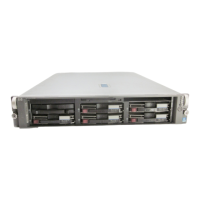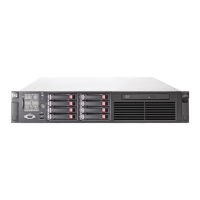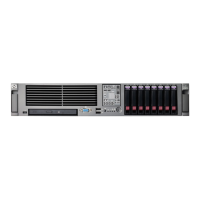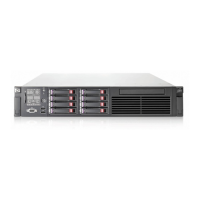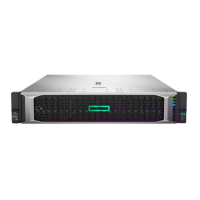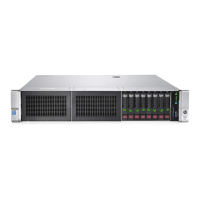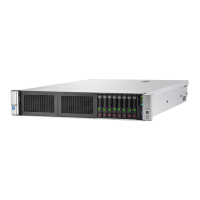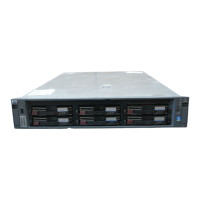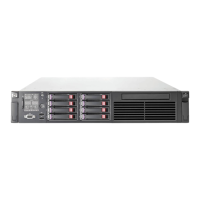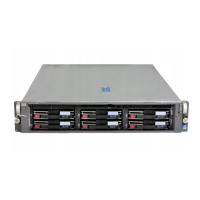Do you have a question about the HP ProLiant DL380e and is the answer not in the manual?
Describes the HP ProLiant Generation 2 and later servers' configuration utility, RBSU.
Explains the steps to run RBSU and modify configuration settings.
Details the RBSU menu structure and information displayed on the screen.
Configures logical COM port number and resources for physical serial ports.
Configures network boot options for embedded Network Interface Controllers (NICs).
Configures protocols for converged network adapters, like iSCSI or FCoE.
Details advanced memory protection features like Advanced ECC, Online Spare.
Details advanced memory protection features like Advanced ECC, Online Spare.
Determines how USB ports and embedded devices operate at startup.
Enables or disables the high-speed USB 2.0 controller.
Selects the search order for USB or SD card devices during boot.
Protects against malicious code by marking non-executable memory.
Allows Virtual Machine Manager to use Intel hardware capabilities.
Enables or disables Intel Hyperthreading Technology for dual logical processors.
Reduces processor power usage and improves performance by disabling cores.
Allows processor to transition to higher frequency based on workload and temperature.
Allows VMM to use Intel VT-d for Directed I/O capabilities.
Selects power profile based on power and performance characteristics.
Configures Power Regulator support, including Dynamic Savings and Static modes.
Configures how the system handles redundant power supply configurations.
Configures advanced power management features for specific server models.
Configures QPI Link Power Management, Processor Idle Power State, etc.
Configures Minimum Processor Idle Power State, Memory Bus Frequency etc.
Configures legacy IRQ for embedded and slot-based PCI/PCIe devices.
Enables and disables embedded and add-in devices, reallocating resources.
Lists slots with add-in cards and allows enabling/disabling their option ROM.
Configures the Initial IPL device and search order for bootable devices.
Selects the primary boot controller for the server to boot from.
Enables or disables the Automatic Server Recovery (ASR) feature.
Sets a timeout limit for resetting a server that is not responding.
Determines when the server automatically powers down due to dangerous temperatures.
Enables or disables the Wake-On LAN feature for remote power-up.
Configures the server to require pressing F1 for errors during power-up.
Disables the momentary power button functionality under any OS.
Enables the server to automatically power on when auxiliary power is applied.
Delays server power-up after a power loss to prevent usage spikes.
Sets a password to control access to the server during power-up.
Sets a password to control access to administrative features of the server.
Configures options for the optional Trusted Platform Module (TPM).
Provides additional selections for enabling BIOS Serial Console.
Enables baud rate changes for BIOS Serial Console.
Enables emergency management console redirection through the serial port.
Selects interface mode (Auto, Command-Line) for POST and utilities.
Defines reference information for the server, like name and asset tag.
Defines reference information for the server administrator.
Defines reference information for the server service contact.
Allows entry of a custom message to display during POST.
Configures ROM loading sequence, MPS Table Mode, and ROM selection.
Controls the embedded video controller behavior with optional controllers.
Allows boot/operation when power supplies don't meet system requirements.
Selects the fan cooling solution for the system (Optimal or Increased Cooling).
Allows modification of serial number and product ID.
Provides options to tune processor and memory performance.
Configures processor prefetch features, node interleaving, and memory speed.
Configures processor prefetch features, hemisphere mode, and node interleaving.
Controls the state of write cache for drives, affecting performance and data safety.
Locks Asset Tag information, preventing erasure upon system setting restoration.
Resets all configuration settings to their default values, losing changes.
Resets settings, date/time, and erases the boot disk.
Enables definition of custom default configuration settings.
Details the RBSU menu structure and information displayed on the screen.
Configures serial ports (A, B, Virtual) and parallel ports (LPT).
Controls diskette drive and NUMLOCK power-on state.
Configures NIC boot support and provides additional memory protection.
Determines how USB ports and embedded devices operate at startup.
Enables or disables the high-speed USB 2.0 controller.
Manages server power usage through different modes.
Configures USB external ports to operate at USB 1.1 or USB 2.0 speeds.
Enables system transition to lowest processor power state.
Configures the Initial IPL device and search order for bootable devices.
Selects the primary boot controller for the server to boot from.
Enables or disables the Automatic Server Recovery (ASR) feature.
Sets a timeout limit for resetting a server that is not responding.
Determines when the server automatically powers down due to dangerous temperatures.
Enables or disables the Wake-On LAN feature for remote power-up.
Configures the server to require pressing F1 for errors during power-up.
Disables the momentary power button functionality under any OS.
Enables the server to automatically power on when auxiliary power is applied.
Delays server power-up after a power loss to prevent usage spikes.
Sets a password to control access to the server during power-up.
Sets a password to control access to administrative features of the server.
Configures options for the optional Trusted Platform Module (TPM).
Enables network server mode, disabling the keyboard port.
Enables or disables keyboard locking via Ctrl+Alt+L.
Provides additional selections for enabling BIOS Serial Console.
Enables baud rate changes for BIOS Serial Console.
Enables emergency management console redirection through the serial port.
Selects interface mode (Auto, Command-Line) for POST and utilities.
Defines reference information for the server, like name and asset tag.
Defines reference information for the server administrator.
Defines reference information for the server service contact.
Allows entry of a custom message to display during POST.
Configures interrupt routing based on OS selection.
Toggles server ROM between current and backup ROM.
Resets all configuration settings to their default values, losing changes.
Resets settings, date/time, and erases the boot disk.
Enables definition of custom default configuration settings.
Enables debug functionality by generating an NMI for OS debugger.
Holds embedded boot drivers for OS installation.
Enables or disables the secondary IDE channel.
Analyzes hard drives for failure and chooses boot drive.
Disables NUMA architecture properties for potential performance gains.
Allows service personnel to change the serial number.
Sets the system product ID found on the chassis sticker.
Controls the state of write cache for drives, affecting performance and data safety.
Enables RAID functionality for the embedded SATA controller.
Enables fan monitoring for optional PCI-X expansion cages.
Provides submenu options for processor settings.
Allows boot/operation when power supplies don't meet system requirements.
Controls the embedded video controller behavior with optional controllers.
Accesses System Maintenance menu for diagnostics, RBSU, and Inspect Utility.
Runs the RBSU utility to configure the server.
Erases system configuration and boot drive for redeployment.
Holds embedded boot drivers for OS installation.
Views system configuration information and saves it to a diskette.
Provides pre-boot checks for server subsystems needed for OS boot.
Verifies presence/readiness of boot controller and OS boot sector.
Automatically configures the system during the first boot without intervention.
Displays options to access RBSU, System Maintenance Menu, or force PXE boot.
Guides through assisted OS installation using the SmartStart CD.
Selects whether to run utilities in CLI or full-screen menu-based mode.
Lists commands and descriptions for the Inspect Utility CLI.
Lists commands for the RBSU CLI, providing equivalent menu functionality.
Lists commands for System Maintenance utilities via CLI.
CLI support for buffering previous commands using arrow keys.
Describes the manual steps to configure an HP server without SmartStart.
Describes using RBSU with the SmartStart Scripting Toolkit for server configuration.
Describes the HP ProLiant Generation 2 and later servers' configuration utility, RBSU.
Explains the steps to run RBSU and modify configuration settings.
Details the RBSU menu structure and information displayed on the screen.
Configures logical COM port number and resources for physical serial ports.
Configures network boot options for embedded Network Interface Controllers (NICs).
Configures protocols for converged network adapters, like iSCSI or FCoE.
Details advanced memory protection features like Advanced ECC, Online Spare.
Details advanced memory protection features like Advanced ECC, Online Spare.
Determines how USB ports and embedded devices operate at startup.
Enables or disables the high-speed USB 2.0 controller.
Selects the search order for USB or SD card devices during boot.
Protects against malicious code by marking non-executable memory.
Allows Virtual Machine Manager to use Intel hardware capabilities.
Enables or disables Intel Hyperthreading Technology for dual logical processors.
Reduces processor power usage and improves performance by disabling cores.
Allows processor to transition to higher frequency based on workload and temperature.
Allows VMM to use Intel VT-d for Directed I/O capabilities.
Selects power profile based on power and performance characteristics.
Configures Power Regulator support, including Dynamic Savings and Static modes.
Configures how the system handles redundant power supply configurations.
Configures advanced power management features for specific server models.
Configures QPI Link Power Management, Processor Idle Power State, etc.
Configures Minimum Processor Idle Power State, Memory Bus Frequency etc.
Configures legacy IRQ for embedded and slot-based PCI/PCIe devices.
Enables and disables embedded and add-in devices, reallocating resources.
Lists slots with add-in cards and allows enabling/disabling their option ROM.
Configures the Initial IPL device and search order for bootable devices.
Selects the primary boot controller for the server to boot from.
Enables or disables the Automatic Server Recovery (ASR) feature.
Sets a timeout limit for resetting a server that is not responding.
Determines when the server automatically powers down due to dangerous temperatures.
Enables or disables the Wake-On LAN feature for remote power-up.
Configures the server to require pressing F1 for errors during power-up.
Disables the momentary power button functionality under any OS.
Enables the server to automatically power on when auxiliary power is applied.
Delays server power-up after a power loss to prevent usage spikes.
Sets a password to control access to the server during power-up.
Sets a password to control access to administrative features of the server.
Configures options for the optional Trusted Platform Module (TPM).
Provides additional selections for enabling BIOS Serial Console.
Enables baud rate changes for BIOS Serial Console.
Enables emergency management console redirection through the serial port.
Selects interface mode (Auto, Command-Line) for POST and utilities.
Defines reference information for the server, like name and asset tag.
Defines reference information for the server administrator.
Defines reference information for the server service contact.
Allows entry of a custom message to display during POST.
Configures ROM loading sequence, MPS Table Mode, and ROM selection.
Controls the embedded video controller behavior with optional controllers.
Allows boot/operation when power supplies don't meet system requirements.
Selects the fan cooling solution for the system (Optimal or Increased Cooling).
Allows modification of serial number and product ID.
Provides options to tune processor and memory performance.
Configures processor prefetch features, node interleaving, and memory speed.
Configures processor prefetch features, hemisphere mode, and node interleaving.
Controls the state of write cache for drives, affecting performance and data safety.
Locks Asset Tag information, preventing erasure upon system setting restoration.
Resets all configuration settings to their default values, losing changes.
Resets settings, date/time, and erases the boot disk.
Enables definition of custom default configuration settings.
Details the RBSU menu structure and information displayed on the screen.
Configures serial ports (A, B, Virtual) and parallel ports (LPT).
Controls diskette drive and NUMLOCK power-on state.
Configures NIC boot support and provides additional memory protection.
Determines how USB ports and embedded devices operate at startup.
Enables or disables the high-speed USB 2.0 controller.
Manages server power usage through different modes.
Configures USB external ports to operate at USB 1.1 or USB 2.0 speeds.
Enables system transition to lowest processor power state.
Configures the Initial IPL device and search order for bootable devices.
Selects the primary boot controller for the server to boot from.
Enables or disables the Automatic Server Recovery (ASR) feature.
Sets a timeout limit for resetting a server that is not responding.
Determines when the server automatically powers down due to dangerous temperatures.
Enables or disables the Wake-On LAN feature for remote power-up.
Configures the server to require pressing F1 for errors during power-up.
Disables the momentary power button functionality under any OS.
Enables the server to automatically power on when auxiliary power is applied.
Delays server power-up after a power loss to prevent usage spikes.
Sets a password to control access to the server during power-up.
Sets a password to control access to administrative features of the server.
Configures options for the optional Trusted Platform Module (TPM).
Enables network server mode, disabling the keyboard port.
Enables or disables keyboard locking via Ctrl+Alt+L.
Provides additional selections for enabling BIOS Serial Console.
Enables baud rate changes for BIOS Serial Console.
Enables emergency management console redirection through the serial port.
Selects interface mode (Auto, Command-Line) for POST and utilities.
Defines reference information for the server, like name and asset tag.
Defines reference information for the server administrator.
Defines reference information for the server service contact.
Allows entry of a custom message to display during POST.
Configures interrupt routing based on OS selection.
Toggles server ROM between current and backup ROM.
Resets all configuration settings to their default values, losing changes.
Resets settings, date/time, and erases the boot disk.
Enables definition of custom default configuration settings.
Enables debug functionality by generating an NMI for OS debugger.
Holds embedded boot drivers for OS installation.
Enables or disables the secondary IDE channel.
Analyzes hard drives for failure and chooses boot drive.
Disables NUMA architecture properties for potential performance gains.
Allows service personnel to change the serial number.
Sets the system product ID found on the chassis sticker.
Controls the state of write cache for drives, affecting performance and data safety.
Enables RAID functionality for the embedded SATA controller.
Enables fan monitoring for optional PCI-X expansion cages.
Provides submenu options for processor settings.
Allows boot/operation when power supplies don't meet system requirements.
Controls the embedded video controller behavior with optional controllers.
Accesses System Maintenance menu for diagnostics, RBSU, and Inspect Utility.
Runs the RBSU utility to configure the server.
Erases system configuration and boot drive for redeployment.
Holds embedded boot drivers for OS installation.
Views system configuration information and saves it to a diskette.
Provides pre-boot checks for server subsystems needed for OS boot.
Verifies presence/readiness of boot controller and OS boot sector.
Automatically configures the system during the first boot without intervention.
Displays options to access RBSU, System Maintenance Menu, or force PXE boot.
Guides through assisted OS installation using the SmartStart CD.
Selects whether to run utilities in CLI or full-screen menu-based mode.
Lists commands and descriptions for the Inspect Utility CLI.
Lists commands for the RBSU CLI, providing equivalent menu functionality.
Lists commands for System Maintenance utilities via CLI.
CLI support for buffering previous commands using arrow keys.
Describes the manual steps to configure an HP server without SmartStart.
Describes using RBSU with the SmartStart Scripting Toolkit for server configuration.
| Bus type | QPI |
|---|---|
| Stepping | M1 |
| FSB Parity | No |
| Scalability | 2S |
| Processor code | SR0LS |
| Processor cache | 10 MB |
| Processor cores | 4 |
| Processor model | E5-2403 |
| System bus rate | 6.4 GT/s |
| Processor series | Intel Xeon E5-2400 |
| Processor socket | LGA 1356 (Socket B2) |
| Processor codename | Sandy Bridge EN |
| Motherboard chipset | Intel C600 |
| Processor frequency | 1.8 GHz |
| Processor cache type | Smart Cache |
| Processor lithography | 32 nm |
| Processor manufacturer | Intel |
| Processor package size | 45 x 42.5 mm |
| Processor front side bus | - MHz |
| Processor operating modes | 64-bit |
| ECC supported by processor | Yes |
| Supported instruction sets | AVX |
| Thermal Design Power (TDP) | 80 W |
| Number of processors installed | 1 |
| Maximum number of PCI Express lanes | 24 |
| Memory types supported by processor | DDR3-SDRAM |
| Memory channels supported by processor | Triple |
| Memory clock speeds supported by processor | 800, 1066 MHz |
| Memory bandwidth supported by processor (max) | 25 GB/s |
| Maximum internal memory supported by processor | 375 GB |
| Memory slots | 12 |
| Internal memory | 4 GB |
| Memory clock speed | 1333 MHz |
| Maximum internal memory | 384 GB |
| Memory layout (slots x size) | 1 x 4 GB |
| HDD size | 3.5 \ |
| RAID levels | 0, 1, 0+1, 5, 5+0 |
| HDD interface | Serial ATA |
| Total storage capacity | 0 GB |
| Maximum storage capacity | - TB |
| Number of HDDs installed | 0 |
| Cabling technology | 10/100/1000Base-T(X) |
| USB 2.0 ports quantity | 6 |
| PCI Express x8 slots | 3 |
| PCI Express slots version | 3.0 |
| Power supply | 460 W |
| Redundant power supply (RPS) support | - |
| Chassis type | Rack (2U) |
| Processor ARK ID | 64615 |
| Intel Identity Protection Technology version | 0.00 |
| Depth | 698.5 mm |
|---|---|
| Width | 445.5 mm |
| Height | 87.4 mm |
| Weight | 42990 g |
